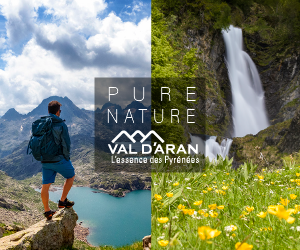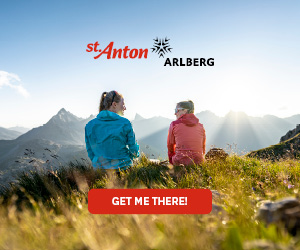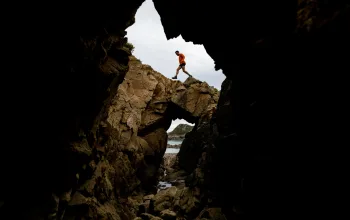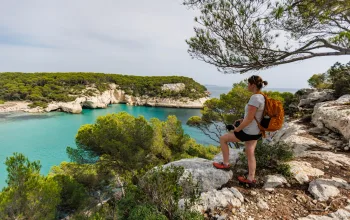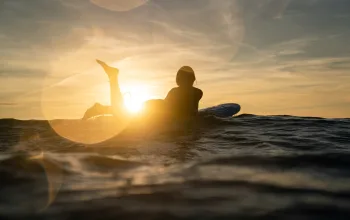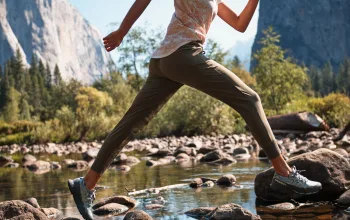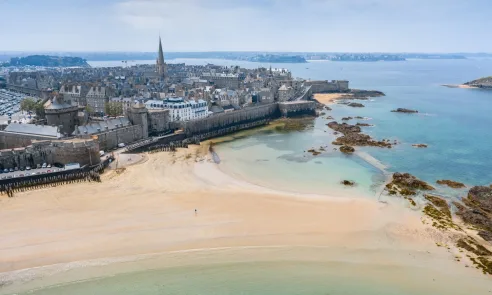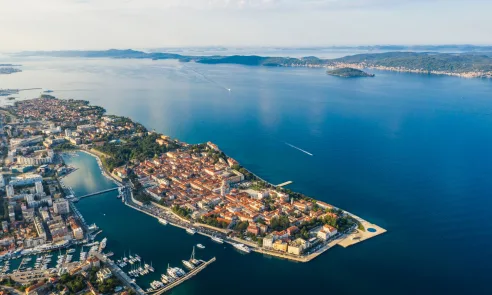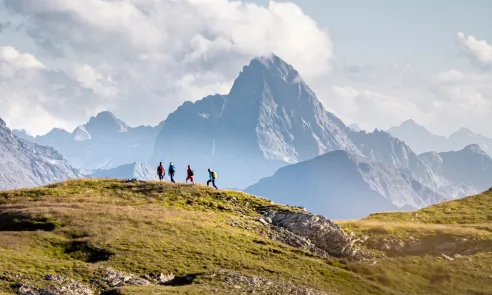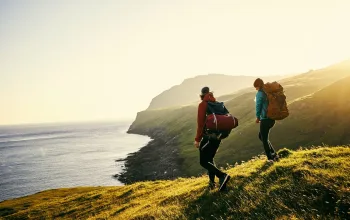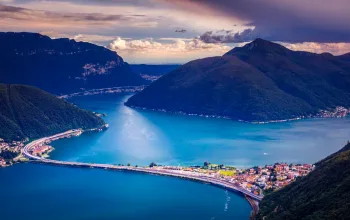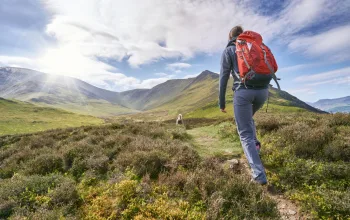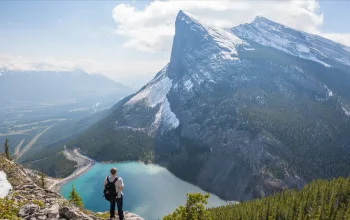Struggling to keep my snorkel out of the water, I have to kick hard, as my two children floating beside me grab a hand each for reassurance, oblivious to the fact that it's making me sink. I can see why they're nervous though, as the enormous fish swirl just below our feet, working up into a feeding frenzy, while we all wonder if we’re on the menu.
Suddenly half a fish thrown from the boat hits the water and starts to sink inches from our faces, leaving a faint cloud of blood in its wake. Both kids have seen it and their little fingers tighten a vicelike grip on my arms as a two metre-long tuna surges from the deep to snatch the fish right in front of us.
Like a silver-plated torpedo with strangely luminous yellow spots spaced out every foot along its spine, the enormous fish passes so close that I feel its wake wash over my submerged face. Both kids explode with excitement, both spluttering through their masks and snorkels as they try to grasp what just happened.
I too am stunned, unable to believe that such a big, fast fish, with razor sharp fins managed to pass so close and yet dodge all our flailing limbs. The second wave that washes over me is one of satisfaction that not only have I been able to get so close to these incredible fish myself but so have my children, who until only yesterday had never even used a snorkel.
We're swimming in the cool Mediterranean waters just off the beach resort and fishing port of L’Amettla de Mar on Catalonia’s Costa Dorada, whose golden rocky coved coastline is lit up by the evening sun on our return.
The day before we were paddling kayaks along that very shore, with only the splashing of paddles and wavelets on plastic hulls echoing around the sea caves, reflected sun spots dancing on the vaulted ceilings. The big red plastic kayaks we were given ideal for scooting in and out of the caves and coves – the only thing making mine slow was my 6 year-old sitting backwards in the stern and dragging her feet in the water.
Halfway through the tour we pulled up the kayaks onto a peaceful sandy beach, a group of walkers disappearing into the shady pines at the far end, no doubt walking part of the Grand Randonée path which runs the whole length of Catalonia’s coastline.
As the kids mucked about in the shallows with the other children in our group, I headed into the deeper water around the headland with our guide, where we spotted sea urchins, numerous little shoals of fish, and starfish.
Back in the kayaks for the return paddle to L’Ametlla’s main beach a headwind had been added to the drag of my human sea anchor.
Beyond the beach ahead of us, along the southern horizon, stretched out a thin, dark green line away from the coastline. Almost incongruously flat and low-lying, this strip of land could only be the Ebro Delta…
Ebro Delta
Far from linear, the Delta is in fact vast, stealing back some 320 square kilometres of sea with silt deposits from the mighty Ebro River to create one of the Western Mediterranean’s biggest wetland areas.
We’ve only driven 30 minutes, but the contrast between this water-logged landscape of paddy fields, and the pine-backed, rocky coves of our first few days on the Costa Daurada is striking.
Thankfully we’ve picked the ideal way to explore this pan-flat nature reserve – electric bikes, which deliver all the immersive pleasures of a bike tour – the sound of the crickets and rustling bulrushes, and tangy smell of the salt marshes – without the downside of having to carry or tow our six and seven-year-olds under our own steam.
Stopping in what seems like the middle of the Delta, rice paddy fields and birdlife-filled lagoons on all sides, we gorge ourselves on the sticky, succulent fruit of a lone fig tree.
It’s apt that from here, our exploration of southern Catalonia – also known as the Terres de l’Ebre – will continue by following the great river Ebro into the interior to Tortosa, with its pan-tiled orange roofs, ornately buttressed cathedral and sprawling hilltop crusader castle.
But unlike the Romans and the Muslim Moors who followed them – ruling here for almost 400 years – we only stop for lunch, where we sample Terres de L’Ebre specialties such as smoked eel, clams, and seafood risotto, followed by light Tortosa cakes with a ‘digestif’ shot of rice liquor chupito.
Pushing further inland we finally leave the Ebro behind for now, heading west, around the back of the Els Ports Natural Park. This is the rugged, craggy landscape of western films, characterised by the totemic, sheer-faced 1000m high limestone Roques de Benet peaks which tower above wooded slopes.
This park is practically unpopulated, with thriving populations of indigenous vultures, Ibex mountain goats, eagles and wildcats making it a haven for hikers, bikers and nature lovers to explore.
We find our hotel to the north of the massif, in the foothills of the Els Ports natural park, in an ancient red earth landscape of scrubland, pine forests and olive groves punctuated by fortified hill-top villages, once ruled by the crusader knights.
Only a stone’s throw away is the medieval village of Horta de Sant Joan, with its narrow cobbled streets and porticoed church square, where we’re lucky enough to see locals practicing for the traditional Catalan Gigantes y capagrossos (giants and bigheads) festival where men in three to four metre-high robed manequins with papier maché heads parade, dance and spin through the villages and towns of the region.
Catalonia's Vias Verdes or 'Green Way'
Our own seemingly giant challenge starts in Horta St Juan the following day. With machines from a busy bike hire shop just off Horta’s main square, we’re taking on a 40km bike ride. Which is worrying in two respects: the first is that my children have never ridden so far in a day before. Ever. The second being that in almost every direction that I look there are mountains…
Which is where Catalonia’s network of Vias Verdes ('green way') trails come in. Converted from abandoned railway lines, these make good use of all the hard-won engineering that railways need for avoiding sharp turns and steep gradients, such as tunnels and bridges.
These long-distance trails are closed to motorised traffic as well, making them safe for all the family. But the real reason we’re being so brave about the distance, is that if you start in Horta and ride east to Benifallet it’s slightly downhill all the way…
We’ve got another ace up our sleeve too: the bike rental company has provided us with connection kits that allow the kids’ bikes to be hitched on or off the adult bikes, effectively turning them into trailers.
These ingenious devices come into their own right from the off as we have to negotiate our way down a steep lane off the hilltop village to the railway path on the valley floor.
It’s late morning by the time we’ve done all the usual family faffing involved in hiring and tweaking bikes and joined our guide for the day. Philippe is a Belgian who runs the Xocolateria Arlequín café in Horta with his wife, and gave us our tour of the village the day before. It's great to have him along but it's not as if we're likely to get lost on a converted singletrack railway trail…
Off at last, we spin easily along the impercetibly dipping route, the paved track gliding us effortlessly through the landscape of olive, pines and almond groves which shade the trail through the broken up, sun-baked, reddy-brown mountains.
With no changes of gradient, no sharp corners and a smooth surface, our easy progress is a stark contrast to the dramatic landscape: Where mountainsides rear up there’s a tunnel; where a ravine opens up there’s a viaduct. It’s almost as if we’re flying.
This route certainly includes some magnificent engineering feats – some 40 tunnels up to 750m long, and viaducts with up to eleven arches – but it's incongruous that the story behind this fantastic cycle route is ultimately one of a failed railway.
Trains only ran on part of the line for about 30 years until a collapse in one of its tunnels closed it for good in 1973.
Foolishly we’d ignored casual advice to bring our own bike lights – surely bike lights are for dark British winters, not long sunny Iberian days? Wrong. Almost all of the tunnels are unlit, and riding straight out of the blazing sun into the pitch dark is like getting a paper bag put over your head.
We have a light on each of the adult bikes provided by the hire shop but they’re not really up to the job – especially given that almost 7.5 km of the 40 km route is in tunnels, several almost a kilometre long.
Unsurprisingly the ‘echo’ game doesn’t make it past the first 10 minutes…
Eager for a break, after about 20 km of riding we park up the bikes and follow Paul down a path to where the grey-blue waters of the river Canalates squeeze though the bottom of a deep ravine under the Fontcalda Sanctuary. This religious site takes its name from the mineral-medicinal hot springs that emerge below the sanctuary itself, and it’s a magical wild swimming spot.
After a few jumps and a swimming explore up the ravine, it’s with great difficulty that we drag ourselves back to the bike trail.
With our minds turning to lunch, which is getting late even by Catalan standards, we hitch up the kid’s bikes to ours and pick up the pace over the remaining four viaducts and through another 14 tunnels.
The last of these viducts – again high over the river Canaletes – marks the border between the Terra Alta and the Baix Ebre counties, and soon we emerge at our final station, Benifallet.
Unlike all the other ghost stations we’ve been gliding through, Benifallet now houses a wonderful rural restaurant, where we enjoy traditional Catalan cuisine on the platform terrace, under shady, sweet-smelling pines.
Flix meandering
Incredibly, our exploration of southern Catalonia is not yet complete, with one last location to discover, appropriately back on the great River Ebro itself.
With an industrial heritage tied to the river, the town of Flix occupies the inside of a wide meander overlooked by a hilltop fort.
Here the river has been partially dammed to divert it through a huge hydro-electic power plant on the narrowest part of the meander where the river almost meets itself.
The upside of this human intervention has been to create a wide, U-shaped curve of calm river water flanked by the Sebes Nature Reserve. We spend a morning in the reserve, spotting reintroduced white storks and meeting beautiful white wild horses brought from the Camargue in the south of France to graze the river banks.
The riverside is teeming with wildlife and we spend our final evening paddling open kayaks and jumping off rocks around the meander. Only after do I show the children pictures of the giant, two-metre long catfish that this river is also famous for...
It's great to be back on the water again, but what a difference between the warm red stone beaches of the Costa Daurada and these dark green, deep river waters up-river. It's a fitting way to round off our exploration of this wonderful region, shaped in so many ways by the mighty river that it is named after.
Later, basking in the reflected warmth of the wild scrubland hillside lit up by the low, setting sun across the river from our hotel balcony, I dream of joining one of the multi-day kayaking trips that run from here, all the way to the coast where we started.
Indeed, with so much more to see and experience in this southern part of Catalonia alone – whose hinterland has revealed so many, and yet evidently so few of its wonders on our short trip – we’re planning the return trip already…



